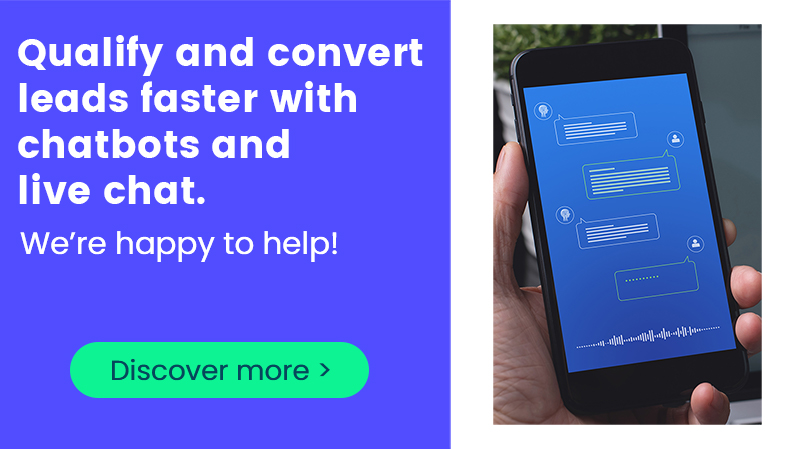- Content Production
How can you make use of chatbots as a B2B company?
Chatbots are an emerging trend in the marketing and service landscape. They appear more and more often on web pages, social media and apps. Chatbots are automated conversational partners that can work completely independently. They don’t have fixed hours or days off, and they ensure that your business has a point of contact anytime, anywhere. With the introduction of artificial intelligence, the possibilities of these digital assistants are almost endless, but how exactly can you deploy them in the B2B world?
Chatbots are currently mainly used in a B2C context, but B2B companies can also benefit from the advantages of this technology. In this blog post, we go over some potential applications of chatbots and explain what the advantages are for both the customer and the company.
> Read also: 5 online lead generation pitfalls
Application 1: help visitors on their way
Welcoming website visitors is a chatbot application that is often used because it is easy to implement and delivers quick results. The assistants are designed so that their appearance and “personality” matches the values of the company, giving a personal touch to each website visit. After a spontaneous welcome, users are given the chance to ask a question or indicate what they are looking for. The chatbot will direct the user to the right web page based on the information they provide. This saves the user valuable time and leads them straight to the right information. If there is not a web page that offers an answer the question, the chatbot can suggest a suitable employee to talk to, based on the information provided by the user. This way, the user does not have to call and then be transferred several times, but is immediately put through to an knowledgeable employee. This has the effect of increasing accessibility.
Application 2: optimise your marketing strategy
Chatbots are a good way to collect qualified B2B leads. If a website visitor or customer asks questions about a particular product or service, you can provide them with relevant information and guide them further along the sales funnel. The challenge is to ensure qualitative interactions, which is often quite complex. The answers your chatbot gives should inform the customer and prompt them into action, without sounding artificial.
In addition, thanks to chatbots, it is no longer necessary for the user to fill out a long and tedious form. You can learn from the customer from the very first interaction. The chatbots are a source of useful data about the different leads and their behaviour. When you ask the right questions, you can get good insights into who the customer is and what stage of the buying process they are in. For customers who are at the beginning of the sales funnel, a simple action like following your social media channel might be enough. On the other hand, for customers who are more advanced in the buying process, you can send targeted promotions or invite them for a chat with an employee.
You can use the data collected by chatbots to not only guide customers through the purchase process, but to also find out which products or services have the highest demand, or which web pages are most visited. This way, you get better insights into the behaviour and wishes of your customers.
Application 3: increasing the efficiency of your customer service
The most common application of chatbots is to improve customer service, as they can be used to increase customer satisfaction while easing the pressure on your service department. Most calls a customer service department receives are about simple, frequently asked questions. When you deploy chatbots as a first-line service agent, customers can get their questions answered very quickly, 24 hours a day, 7 days a week. This will reduce the pressure on your service department, which in turn greatly reduces customer waiting times and allows your customer service department to focus on what is truly important. If the question the customer asks is too difficult and cannot be answered immediately by the chatbot, it will still refer the customer to the service department. Chatbots can also be used here, as they can present visitors with a list of pre-defined questions in order to determine which customer service department can best help with their problem. This strategy saves money and increases customer satisfaction because you can improve the service before and after the purchase.
Social media and chatbots
“Chatbots integrated on owned media, such as websites and blogs, and are the most common bots in the business world. But the list of platforms where you can deploy them is quite extensive. Here are some examples:
Twitter is a platform that is often used to ask questions or to contact customer service. Research conducted by Twitter shows that 41% of its active users use the platform to reach customer service, while 25% use it to get more information about products or services. Due to the large number of requests, it is often difficult for companies to respond within an acceptable timeframe, and this is where Twitter chatbots come in handy. Twitter is open to chatbot integrations and has even written its own guide on how to plan and implement chatbots on the platform.
In 2018, WhatsApp introduced its business platform—an app that gives businesses more options for connecting with their customers. For example, the platform can be used to promote specific items, or allow customers to contact the company directly for support. You can use built-in tools such as the “conversational builder” and “conversation AI” to create chatbot-like conversations, making your business accessible anywhere, anytime. WhatsApp chatbots are mostly used for sending updates, including notifying customers of delivery status and other important information such as payments, returns and product availability. WhatsApp is an attractive platform for chatbots as it is easy to implement, widely used and offers a high opening rate.
Facebook Messenger
Facebook Messenger has been the leader in social media chatbots, with and easy implementation and a large catalogue of tools. However, this month the platform started rolling out its Lightspeed update, a new version of the app that no longer includes many features, including chatbot functionality. Facebook has streamlined Messenger to optimise speed and data usage. It’s unclear whether the platform will be reverting to chatbots in the future.”
Reduce costs by using chatbots
Customer service is expensive because you need to have a team ready to answer questions or receive calls all the time. The introduction of chatbots allows you to partially automate this process, saving you money on aspects such as infrastructure, wages and staff training. Although programming a fully-fledged chatbot is an expensive and often very complex task, this investment can pay off in the long run.
However, chatbots are not only used to reduce costs, they can also bring in extra revenue because they can support your company’s marketing strategy. By attracting more leads and increasing the number of conversions, you can enjoy extra income.
The potential of chatbots is clear: they are able to support your business and improve the customer experience, which brings a number of new opportunities. The capabilities of these voice assistants are already quite extensive and are being broadened and improved year by year. Although the technology is currently still in a growth phase, in a few years’ time it will be impossible to imagine the business landscape without chatbots.


How do you provide feedback on texts in large organisations?

14 redenen waarom jouw contentmarketing niet werkt
Heb je weinig of zwakke leads, weinig bezoekers, weinig clicks? We sommen in deze whitepaper 14 redenen op waardoor het fout kan lopen en geven tips hoe je dit kan vermijden.

